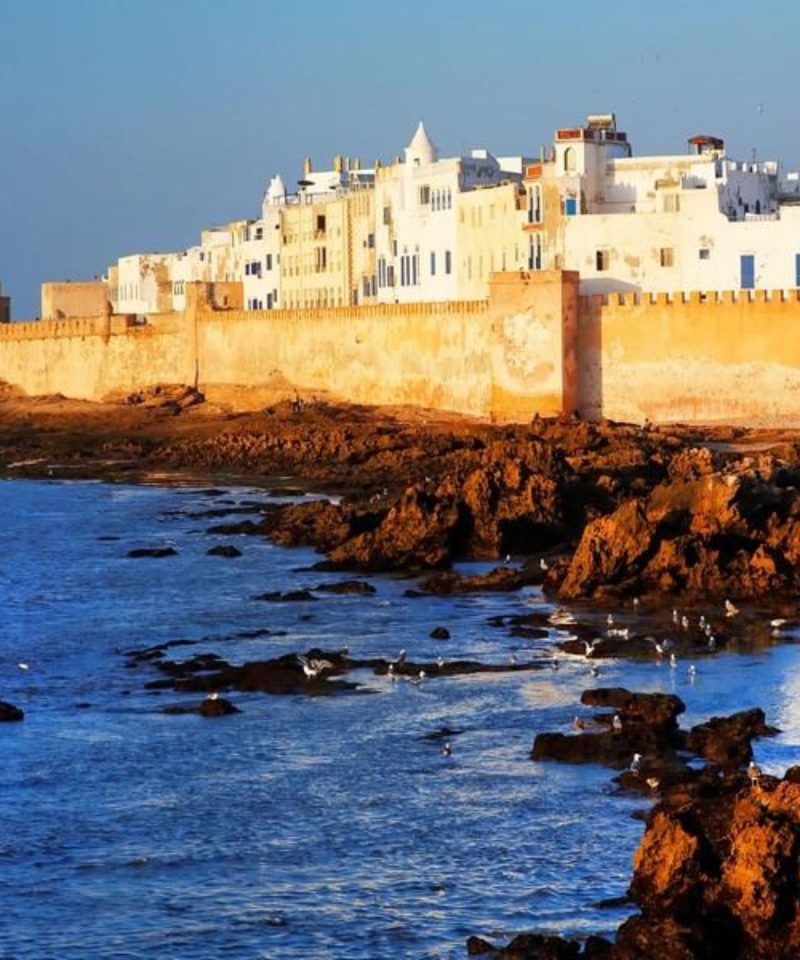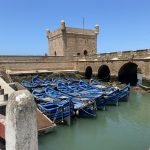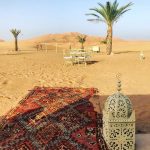History
Archaeological research shows that Essaouira has been occupied since prehistoric times. The bay at Essaouira is partially sheltered by the island of Mogador, making it a peaceful harbor protected against strong marine winds.
Antiquity
Essaouira has long been considered one of the best anchorages of the Moroccan coast. The Carthaginian navigator Hanno visited in the 5th century BC and established the trading post of Arambys.
Around the end of the 1st century BCE or early 1st century CE, the Berber king Juba II established a Tyrian purple factory, processing the murex and purpura shells found in the intertidal rocks at Essaouira and the Iles Purpuraires. This dye colored the purple stripe in the togas worn by the Senators of Imperial Rome.
A Roman villa was excavated on Mogador island. A Roman vase was found as well as coinage from the 3rd century CE. Most of the artifacts are now visible in the Sidi Mohammed ben Abdallah Museum and the Rabat Archaeological Museum.
Early modern period
During the Middle Ages, a Muslim saint named Sidi Mogdoul was buried in Essaouira, probably giving its origin to the name “Mogador”.
Portuguese establishment (1506–1510)
In 1506, the king of Portugal, D. Manuel I, ordered a fortress to be built there, named Castelo Real de Mogador. Altogether, the Portuguese are documented to have seized six Moroccan towns and built six stand-alone fortresses on the Moroccan Atlantic coast, between the river Loukos in the north and the river of Sous in the south. Four of them only had a short duration: Graciosa (1489), São João da Mamora (1515), Castelo Real of Mogador (1506–10) and Aguz (1520–25). Two became permanent urban settlements: Santa Cruz do Cabo de Gué (modern Agadir, founded in 1505–06), and Mazagan, founded in 1514–17. Following the 1541 Fall of Agadir, the Portuguese had to abandon most of their settlements between 1541 and 1550, although they were able to keep Ceuta, Tangier and Mazagan.
The fortress of Castelo Real of Mogador fell to the local resistance of the Regraga fraternity four years after its establishment, in 1510.
During the 16th century, powers including Spain, England, the Netherlands and France tried in vain to conquer the locality. Essaouira remained a haven for the export of sugar and molasses and as an anchorage for pirates.
De Razilly expedition (1629)
France was involved in an early attempt to colonize Mogador in 1629. As Richelieu and Père Joseph were attempting to establish a colonial policy, Admiral Isaac de Razilly suggested they occupy Mogador in 1626, which he had reconnoitered in 1619. The objective was to create a base against the Sultan of Morocco and asphyxiate the harbour of Safi.
He departed for Salé on 20 July 1629 with a fleet composed of the ships Licorne, Saint-Louis, Griffon, Catherine, Hambourg, Sainte-Anne, Saint-Jean. He bombarded the city the Salé, destroyed three corsair ships, and then sent the Griffon under Captain Treillebois to Mogador. The men of Razilly saw the fortress of Castelo Real in Mogador and landed 100 men with wood and supplies on Mogador island, with the agreement of Richelieu. After a few days, however, the Griffon reembarked the colonists and departed to rejoin the fleet in Salé.
After these expeditions, France signed a treaty with Abd el-Malek II in 1631, giving France preferential treatment, known as “capitulations”: preferential tariffs, the establishment of a Consulate, and freedom of religion for French subjects.
Foundation of modern Essaouira (1760–1770)
The present city of Essaouira was built during the mid-eighteenth century by the Moroccan King. Mohammed III tried to reorient his kingdom toward the Atlantic for increased exchanges with European powers, choosing Mogador as his key location. One of his objectives was to establish a harbour at the closest possible point to Marrakesh. The other was to cut off trade from Agadir in the south, which had been favouring a political rival of Mohammed III, and the inhabitants of Agadir were forced to relocate to Essaouira.
For 12 years, Mohammed III directed a French engineer, Théodore Cornut, and several other Moroccan and European architects and technicians to build the fortress and city along modern lines. Originally called “Souira” (“the small fortress”), the name became “Es-Saouira” (“the beautifully designed”).
Thédore Cornut designed and built the city itself, particularly the Kasbah area, corresponding to the royal quarters and the buildings for Christian merchants and diplomats. Other parts were built by other architects, including Moroccan architects especially from Fez, Marrakesh, and Rabat. The harbour entrance, with the “Porte de la Marine”, was built by an English renegade by the name of Ahmed el Inglizi (“Ahmed the English”) or Ahmed El Alj (“Ahmed the Renegade”). Mohammed III took numerous steps to encourage the development of Essaouira including closing off the harbour of Agadir to the south in 1767 so that southern trade could be redirected through Essaouira. European communities in the northern harbour of Rabat-Salé were ordered to move to Essaouira through an ordinance of 21 January 1765.
From the time of its rebuilding by Muhammad III until the end of the nineteenth century, Essaouira served as Morocco’s principal port, offering the goods of the caravan trade to the world. The route brought goods from sub-Saharan Africa to Timbuktu, then through the desert and over the Atlas mountains to Marrakesh. The road from Marrakesh to Essaouira is a straight line, explaining the king’s choice of this port among the many others along the Moroccan coast.
Jewish presence
Mohammed III encouraged Moroccan Jews to settle in the town and handle the trade with Europe. Jews once comprised the majority of the population, and the Jewish quarter (or mellah) contains many old synagogues. The town also has a large Jewish cemetery. The city flourished until the caravan trade died, superseded by direct European shipping trade with sub-Saharan Africa. Changes in trade, the founding of Israel, the resulting wars with Arab states, and the independence of Morocco all resulted in Sephardic Jews leaving the country. As of 2017, Essaouira had only three Jewish inhabitants. On 15 January 2020, King Mohammed VI visited “Bayt Dakira”, a Jewish heritage house, in Essaouira.
European trade and diplomacy
In the 19th century, Essaouira became the first seaport of Morocco, with trade volumes about double those of Rabat. The city functioned as the harbour for Marrakesh, as it was only a few days from the inland city. Diplomatic and trade representations were established by European powers in Essouira. In the 1820s, European diplomats were concentrated in either Tangier or Essaouira.
French interventions and Protectorate
Following Morocco’s alliance with Algeria’s Abd-El-Kader against France, Essaouira was bombarded and briefly occupied by the French Navy under the Prince de Joinville on 16 August 1844, in the Bombardment of Mogador, an important battle of the First Franco-Moroccan War.
From 1912 to 1956, Essaouira was part of the French protectorate of Morocco. Mogador was used as a base for a military expedition against Dar Anflous, when 8,000 French troops were located outside the city under the orders of Generals Franchet d’Esperey and Brulard. The Kasbah of Dar Anflous was taken on 25 January 1913. In 1930, brothers, Michel and Jean Vieuchange used Essaouira as a base before Michel set off into the Western Sahara to try to find Smara.
France had an important administrative, military and economic presence. Essaouira had a Franco-Moroccan school, still visible in Derb Dharb street. Linguistically, many Moroccans of Essaouira speak French fluently today.
Recent years
In the early 1950s film director and actor Orson Welles stayed at the Hotel des Iles just south of the town walls during the filming of his 1952 classic version of “Othello” which contains several memorable scenes shot in the labyrinthine streets and alleyways of the medina. Legend has it that during Welles’ sojourn in the town he met Winston Churchill, another guest at the Hotel des Iles. A bas-relief of Orson Welles is located in a small square just outside the medina walls close to the sea. Several other film directors have utilized Essaouira as a location due to the photogenic and atmospheric qualities.
The town was used in the filming of “The Game of Thrones” as the home of the Army of the Unsullied. The scene of the rows of crucified slaves were props to cover the Portuguese cannons.
Beginning in the late 1960s, Essaouira became something of a hippie hangout.
Geography
Essaouira is protected by a natural bay partially shielded from wave action by the Iles Purpuraires. A broad sandy beach extends from the harbour south of Essaourira, at which point the Oued Ksob discharges to the ocean; south of the discharge lies the archaeological ruin, the Bordj El Berod. The Canary Current is responsible for the generally southward movement of ocean circulation and has led to enhancement of the local fishery. The village of Diabat lies about five kilometres (3.1 miles) south of Essaouira, immediately south of the Oued Ksob.
Essaouira connects to Safi to the north and to Agadir to the south via the N1 road and to Marrakech to the east via the R 207 road. There is a small airport some 7 to 8 km (4 to 5 mi) away from the town, which schedules several flights a week to Paris-Orly, London-Luton and Brussels-South (Charleroi) and daily to Casablanca.






